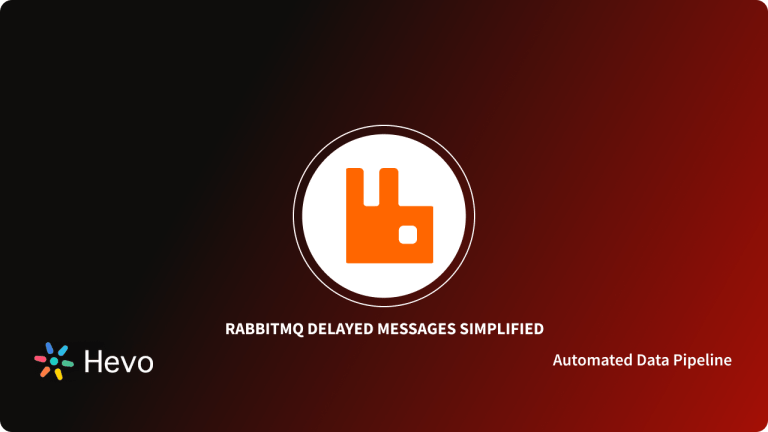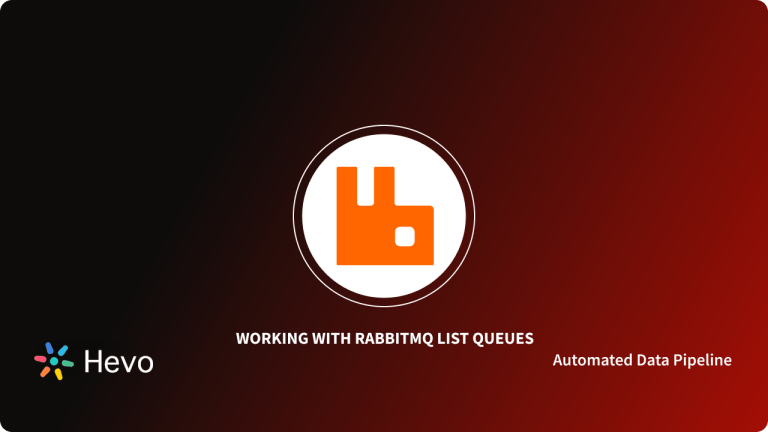Message queuing (MQ) is a service that allows application-to-application communication services regardless of where the application or data are located. It helps applications to communicate with one another via messages routed between them by a message broker. The Message Broker was created to expand MQ, and it is capable of comprehending the content of each message that passes through it.
In this article, we will learn about two widely used message brokers – RabbitMQ VS ActiveMQ.
Both the brokers are open-source and were designed to tackle real-time challenges faced during communication. However, many find it difficult to understand the prominent differences between these two. Thus, this article describes the key differences between RabbitMQ VS ActiveMQ. along with their benefits.
Table of Contents
Understanding RabbitMQ
RabbitMQ is a free, open-source, and scalable messaging solution that aids in the smooth operation of a variety of online applications. It supports AMQP (Advanced Message Queuing Protocol), MQTT (Message Queuing Telemetry Transport), and STOMP (Streaming Text Oriented Messaging Protocol). RabbitMQ is an Erlang-based messaging system that allows you to build strong, dependable, fault-tolerant, and highly scalable systems that can handle several tasks at the same time.
It serves as a middleware layer that allows multiple applications in organizations to communicate without the fear of message loss while meeting various quality of service (QoS) standards. RabbitMQ uses queues to store messages in a logical order and allow requesters and responders to share messages. However, each RabbitMQ message can only have one subscriber by default and is removed after it is accessed/consumed.
Features of RabbitMQ
- Open Source: RabbitMQ is an open-source project developed in Erlang that leverages the strength of Pivotal’s commercial offerings. Being an active open source community, RabbitMQ continuously works towards enhancing the solution for better reliability.
- Platform and vendor-neutral: The message broker is accessible for most programming languages and on all major platforms thanks to the Advanced Message Queuing Protocol (AMQP) specification’s platform- and vendor-neutral implementation.
- Client libraries for most modern languages: RabbitMQ’s client libraries operate on a number of platforms and support the majority of modern programming languages. This makes it an appealing broker for developing improved solutions. Because there are no vendor or language limits when designing programs that communicate with it, it is commonly used as a significant component of applications written in a variety of languages. RabbitMQ is a handy data transmission interface for Java, Ruby, Python, PHP, JavaScript, and C#.
- Layers of security: RabbitMQ includes a number of security features. Client connections can only be secured via SSL-encrypted communications and client certificates. Access to resources and messages may be managed at the virtual-host level, ensuring that messages and resources are segregated.
- Plugins for higher-latency environments: RabbitMQ supports messaging for low-latency contexts and plugins for higher-latency settings, such as the internet, because not all network topologies and architectures are the same. Federated messages may be exchanged across several data centers by clustering RabbitMQ on the same local network.
- Flexibility in controlling messaging trade-offs: RabbitMQ lets you manage the trade-offs between message throughput and performance while ensuring messaging reliability. Messages can indicate whether they should be stored on a disc before being delivered, as it is not a “one-size-fits-all” application. Queues may also be made highly available by spanning many servers to ensure that messages are not lost in the case of a server failure.
Hevo Data, a No-Code Data Pipeline Platform, empowers you to ETL your data from a multitude of sources to Databases, Data Warehouses, or any other destination of your choice in a completely hassle-free & automated manner.
Check out what makes Hevo amazing:
- It has a highly interactive UI that is easy to use.
- It streamlines your data integration task and allows you to scale horizontally.
- The Hevo team is available around the clock to provide exceptional support to you.
Hevo has been rated 4.7/5 on Capterra. Know more about our 2000+ customers and give us a try.
GET STARTED WITH HEVO FOR FREEUnderstanding ActiveMQ

ActiveMQ is a message broker that acts as a communication link between multiple components on separate servers or written in different programming languages. In other words, ActiveMQ is the message-oriented middleware (MOM) software that enables applications to connect with one another. It uses standards-based, asynchronous communication to create loose coupling between services in an application, which is the foundation of messaging systems and distributed applications.
It comprises extensions such as STOMP, JMS, and OpenWire, and its primary function is to convey messages between applications. It can handle a variety of transport protocols as well as business functions. Additionally, rather than requiring both ends to be online at the same time in order to interact, ActiveMQ may connect many clients and servers and queue messages.
Features of ActiveMQ
- Connectivity: ActiveMQ supports HTTP/S, IP multicast, SSL, STOMP, TCP, UDP, XMPP, and other protocols for better connection. A messaging platform that supports many protocols decreases adoption hurdles because many existing systems use a specific protocol and do not have the opportunity to switch.
- Pluggable persistence and security: ActiveMQ can be fully customized for the type of authentication and authorization that’s best for you. As an example, ActiveMQ offers its style of message persistence via KahaDB, but it also supports standard JDBC-based databases. The ActiveMQ application supports its authentication and authorization mechanisms using properties files and standard JAAS login modules.
- Client API: ActiveMQ also has APIs in C/C++,.NET, Perl, PHP, Python, Ruby, and more languages in addition to Java. Despite the fact that ActiveMQ operates on a Java virtual machine, ActiveMQ clients may be built in any language.
- Simplified Administration Support: ActiveMQ was created with developers in mind. It does not, however, require a specialized administrator due to its easy-to-use and strong administrative capabilities. ActiveMQ may be monitored via the ActiveMQ Management Console, JConsole, and the ActiveMQ web console, among other tools. You may also process ActiveMQ advisory messages and run command-line scripts.
- Broker Clustering: To improve scalability, several ActiveMQ brokers can operate together as a federated network. A network of brokers is an example of this, as it may accommodate a variety of topologies.
RabbitMQ vs ActiveMQ: Understanding the Key Differences
| Feature | RabbitMQ | ActiveMQ |
| Scalability | Built-in clustering for horizontal scalability; linear expansion by adding nodes. | Typically, it uses a network of brokers; a single broker is sufficient for basic needs. |
| Deployment | Horizontal and vertical scaling doesn’t support traffic partitioning. | It supports vertical, and horizontal scaling and traffic partitioning. |
| Origin and License | Developed by Pivotal Software, under Mozilla Public License (MPL). | Developed by Apache Software Foundation, under Apache License. |
| Supporting Languages | Written in Erlang; supports C, C++, Java, Python, Ruby, and PHP. | Written in Java; supports C/C++, .NET, Perl, PHP, Python, and Ruby. |
| Synchronization Methods | Operates in both synchronous and asynchronous modes. | The default is synchronous and can be changed to asynchronous. |
| Messaging Techniques | PUB-SUB, Message Queue, RPC, Routing. | PUB-SUB, P2P (Point-to-Point). |
RabbitMQ vs ActiveMQ: Scalability
The scalability factor has a direct impact on the performance of any application in RabbitMQ vs ActiveMQ. In most cases, a single ActiveMQ broker is sufficient to meet all the application’s requirements. However, to satisfy more complicated messaging scenarios, a network of brokers is often used to construct a cluster made of many ActiveMQ interconnected servers. Whereas, RabbitMQ’s built-in clustering is one of its most remarkable features, distinguishing it from nearly all other open-source message brokers. The clustering method was constructed with two purposes: keeping consumers and producers functioning if one of the nodes fails and linearly expanding message throughput by adding additional nodes.
RabbitMQ vs ActiveMQ: Deployment
While deploying an application, scaling plays an essential role in determining any application’s latency and performance metrics for RabbitMQ vs ActiveMQ. There are three types of scaling methods – Vertical, Horizontal, and Traffic Partitioning. The vertical scaling strategy deploys a large number of connections in a single broker. On the other hand, horizontal scaling takes advantage of networks to expand the number of brokers available to your applications. The third hybrid deployment technique is traffic partitioning, which combines vertical scaling and horizontal techniques. The ActiveMQ broker offers all three different types of scaling methods. However, RabbitMQ can only be scaled horizontally and vertically.
RabbitMQ vs ActiveMQ: Origin and License
RabbitMQ is a message broker and queueing server implemented on Advanced Message Queuing Protocol (AMQP) that allows transferring data across applications using a standard protocol. It was developed by Pivotal Software under the Mozilla Public License. However, ActiveMQ is a Java Message Service (JMS) based compliant, message-oriented middleware (MOM) developed by the Apache Software Foundation and holds the Apache License. This license allows users to modify ActiveMQ without repercussions for the redistribution of changes.
RabbitMQ vs ActiveMQ: Supporting Languages
RabbitMQ is written in Erlang or OTP language, and it also supports languages such as C, C++, Javascript, Java, Python, Ruby, and PHP. ActiveMQ, on the other hand, is written in Java and supports APIs for a wide range of languages, including C/C++, .NET, Perl, PHP, Python, Ruby, and many more.
RabbitMQ vs ActiveMQ: Synchronization Methods
The synchronization technique directly influences the product’s functioning in RabbitMQ vs ActiveMQ. RabbitMQ can work in both synchronous and asynchronous modes of operation. However, ActiveMQ is configured to operate in synchronous mode by default, but this may be changed to the asynchronous mode by modifying the default configuration.
RabbitMQ vs ActiveMQ: Messaging Techniques
With the help of the ActiveMQ broker, it is possible to carry out messaging techniques such as PUB-SUB and P2P. PUB-SUB allows sending and receiving messages that don’t need to know much about sender and receiver end. Whereas, P2P allows the sender to know information about the receiver end before it can send a message to that application. While, RabbitMQ allows general message technique PUB-SUB with additional patterns such as Message Queue, RPC, and Routing.
Conclusion
In addition to routing, message brokers can often translate message formats and protocols to help connect various applications. Message brokers work as the building blocks of message-oriented middleware for a complete messaging solution. Both RabbitMQ vs ActiveMQ are highly scalable, high-performance, and reliable message brokers.
Companies uses various trusted source as it provides many benefits but transferring data from it into a data warehouse is a hectic task. The Automated data pipeline helps in solving this issue and this is where Hevo comes into the picture. Hevo Data is a No-code Data Pipeline and has awesome 150+ pre-built Integrations that you can choose from.
SIGN UP for a 14-day free trial and see the difference!
Share your experience of learning about RabbitMQ vs ActiveMQ in the comments section below.
FAQs
1. What is the difference between RabbitMQ, ActiveMQ, and Kafka?
RabbitMQ: Uses AMQP for reliable messaging, supports various protocols, and is ideal for complex routing.
ActiveMQ: Java-based, uses JMS, supports pub/sub and point-to-point messaging.
Kafka: Distributed, high-throughput platform, best for real-time data streams and event-driven architectures.
2. Which message broker is best?
It depends on your needs:
RabbitMQ for reliability and protocol flexibility.
ActiveMQ for Java applications.
Kafka for high-volume, real-time data streaming and scalability.
3. What is the difference between RabbitMQ and MQ?
RabbitMQ: Open-source, uses AMQP, great for flexible routing.
MQ (IBM MQ): Enterprise-level, supports multiple protocols, focuses on security, clustering, and transactionality for critical systems.




